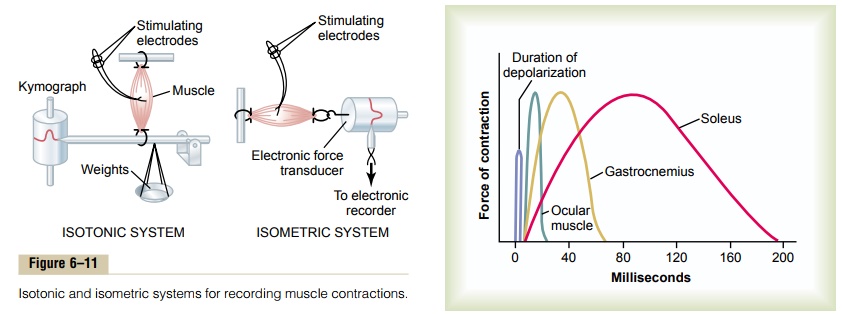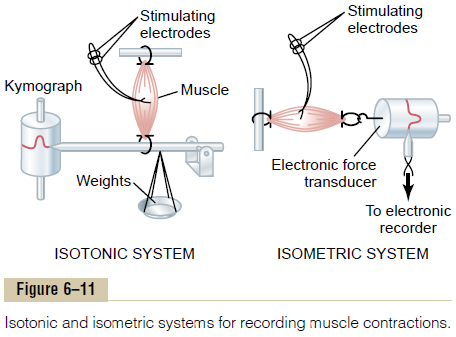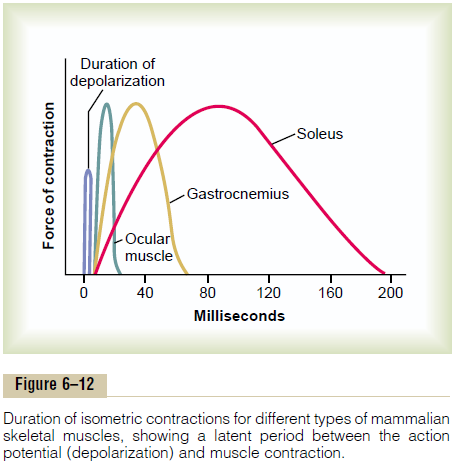Chapter: Medical Physiology: Membrane Physiology, Nerve, and Muscle : Contraction of Skeletal Muscle
Characteristics of Whole Muscle Contraction

Characteristics of Whole Muscle Contraction
Many features of muscle contraction can be demonstrated by eliciting single muscle twitches. This can be accomplished by instantaneous electrical excitation of the nerve to a muscle or by passing a short electrical stimulus through the muscle itself, giving rise to a single, sudden contraction lasting for a fraction of a second.
Isometric Versus Isotonic Contraction. Muscle contraction issaid to be isometric when the muscle does not shorten during contraction andisotonic when it does shorten but the tension on the muscle remains constant throughout the contraction. Systems for recording the two types of muscle contraction are shown in Figure 6–11.

In the isometric system, the muscle contracts against a force transducer without decreasing the muscle length, as shown on the right in Figure 6–11. In the iso-tonic system, the muscle shortens against a fixed load; this is illustrated on the left in the figure, showing a muscle lifting a pan of weights. The characteristics of isotonic contraction depend on the load against which the muscle contracts, as well as the inertia of the load. However, the isometric system records strictly changes in force of muscle contraction itself. Therefore, the iso-metric system is most often used when comparing the functional characteristics of different muscle types.
Characteristics of Isometric Twitches Recorded from Different
Muscles. The human body has many sizes of skeletalmuscles—from the very small stapedius muscle in the middle ear, measuring only a few millimeters long and a millimeter or so in diameter, up to the very large quadriceps muscle, a half million times as large as the stapedius.

Further, the fibers may be as small as 10 micrometers in diameter or as large as 80 micrometers. Finally, the energetics of muscle contraction vary con-siderably from one muscle to another. Therefore, it is no wonder that the mechanical characteristics of muscle contraction differ among muscles.
Figure 6–12 shows records of isometric contractions of three types of skeletal muscle: an ocular muscle, which has a duration of isometric contraction of less than 1/40 second; the gastrocnemius muscle, which has a duration of contraction of about 1/15 second; and the soleus muscle, which has a duration of contrac-tion of about 1/3 second. It is interesting that these dura-tions of contraction are adapted to the functions of the respective muscles. Ocular movements must be extremely rapid to maintain fixation of the eyes on specific objects to provide accuracy of vision. The gas-trocnemius muscle must contract moderately rapidly to provide sufficient velocity of limb movement for running and jumping, and the soleus muscle is con-cerned principally with slow contraction for continual, long-term support of the body against gravity.
Fast Versus Slow Muscle Fibers. As we discuss on sports physiology, every muscle of the body is composed of a mixture of so-called fast andslow muscle fibers, with still other fibers gradated between these two extremes. The muscles that react rapidly are composed mainly of “fast” fibers with only small numbers of the slow variety. Conversely, the muscles that respond slowly but with prolonged contraction are composed mainly of “slow” fibers. The differences between these two types of fibers are as follows.
Fast Fibers. (1) Large fibers for great strength of con-traction. (2) Extensive sarcoplasmic reticulum for rapid release of calcium ions to initiate contraction. (3) Large amounts of glycolytic enzymes for rapid release of energy by the glycolytic process. (4) Less extensive blood supply because oxidative metabolism is of secondary importance. (5) Fewer mitochondria, also because oxidative metabolism is secondary.
Slow Fibers. (1) Smaller fibers. (2) Also innervated bysmaller nerve fibers. (3) More extensive blood vessel system and capillaries to supply extra amounts of oxygen. (4) Greatly increased numbers of mitochondria, also to support high levels of oxidative metabolism. (5) Fibers contain large amounts of myoglobin, an iron-containing protein similar to hemoglobin in red blood cells. Myoglobin combines with oxygen and stores it until needed; this also greatly speeds oxygen transport to the mitochondria. The myoglobin gives the slow muscle a reddish appearance and the name red muscle,whereas a deficit of red myoglobin in fast muscle gives it the name white muscle.
Related Topics